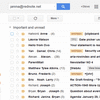I agree with Tom Dale. Yup, you read that right: I agree with Tom Dale. Well, he finally said something sensible:
Say what you will about server-rendered apps, the performance of your server is much more predictable, and more easily upgraded, than the many, many different device configurations of your users. Server-rendering is important to ensure that users who are not on the latest-and-greatest can see your content immediately when they click a link.
You might remember Tom as the guy who declared progressive enhancement dead in late 2013. He’s apparently seen the light and has been hard at work to get Ember ready for server side rendering.
I’m shocked, but glad he finally came around. Progressive enhancement FTW!






